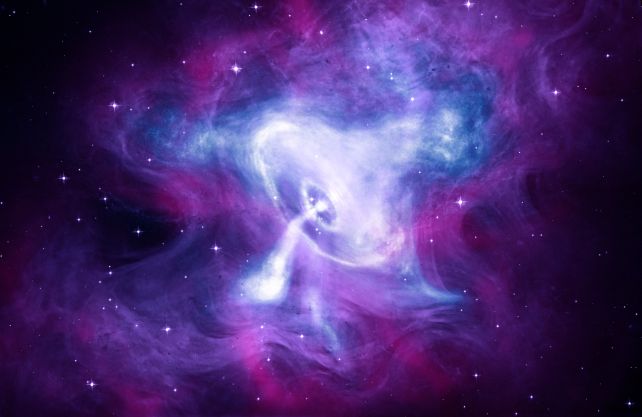
In a groundbreaking achievement, we now possess firsthand observational proof of the celestial mechanism responsible for the creation of neutron stars and black holes.
Scientists witnessed the birth of a celestial entity exhibiting characteristics typical of compact objects during the explosion of a nearby galaxy’s supernova. Although the specific type—neutron star or black hole—is yet undetermined, this discovery unequivocally affirms that the core collapse of massive stars results in the formation of the densest entities in the Universe, marked by a spectacular explosion of stellar material.
It is believed that processes similar in nature give rise to stellar-mass black holes and neutron stars.
As a star approaches the end of its life, it depletes the fuel necessary for sustaining fusion, the process that fuels its luminosity. Following a somewhat intricate sequence of events, the star expels its outer material. Subsequently, the core, lacking the support of fusion’s outward pressure, succumbs to gravity and transforms into an exceptionally dense object (applicable to most stars).
The destiny of the resulting object hinges on its mass. Stars with a mass less than eight times that of the Sun give rise to a white dwarf, mirroring the predicted fate of the Sun itself.
Should the initial star possess a mass ranging from about 8 to 30 times that of the Sun, the core undergoes collapse, forming a neutron star with a mass of up to approximately 2.3 solar masses.
Stars with masses exceeding 30 times that of the Sun culminate in the formation of stellar-mass black holes.
However, our comprehension of this process is primarily drawn from observations of its aftermath. Notable examples include neutron stars within the Milky Way, emitting light from within the remnants of the supernova explosion that marked their birth. Instances like the renowned Crab Pulsar and the Vela Pulsar (a subtype of neutron star) offer valuable insights.

A supernova event within the Milky Way has eluded our observation for centuries. Even if one occurred, discerning the remnants might prove challenging. The most recent nearby supernova, observed in 1987 in the Large Magellanic Cloud, is obscured by considerable dust, hindering our ability to observe the presumed core remnant. This underscores the difficulties in studying the aftermath of a supernova millions of light-years away.
Contrary to previous assumptions, Supernova SN 2022jli was initially detected last year, erupting within the spiral galaxy NGC 157, positioned just 75 million light-years away. Due to the limited understanding of this process, scientists were immediately captivated, directing telescopes towards NGC 157 to observe the supernova’s progression—brightening, peaking, and gradually dimming over the subsequent days, weeks, and months.

Typically, this unfolds as a seamless process, yielding a diminishing light curve that forms a nearly consistent line.
However, SN 2022jli exhibited an unusual behavior. After reaching its peak, rather than fading uniformly, it underwent a periodic fluctuation in brightness. Every 12.4 days throughout the 200-day observation period, the supernova experienced cycles of brightening followed by a gradual dimming.
This is the first time,
wrote a team led by astrophysicist Thomas Moore of Queen’s University Belfast in a paper released last year, that repeated periodic oscillations, over many cycles, have been detected in a supernova light curve.
Recently, another group, spearheaded by astrophysicist Ping Chen from the Weizmann Institute of Science in Israel, has unraveled the mystery behind this phenomenon.
Astronomers commonly posit that the majority of stars are not solitary entities but instead have companion stars. It is probable that the star responsible for SN 2022jli had a binary companion that endured the supernova event, persisting in orbit alongside the now-exploded object.
Chen and his team detected bursts of gamma radiation and observed the movement of hydrogen in the region where the supernova occurred. Their analysis indicates that the fluctuations in brightness likely result from an interaction between the SN 2022jli remnant and its companion star. During the ejection of outer material by SN 2022jli, it caused the companion star to expand with hydrogen.

Following the explosion, the orbital movement of the two entities brings the condensed core remnant through the extended atmosphere of the companion. In this process, the remnant absorbs a substantial amount of hydrogen. As this hydrogen descends onto the remnant, it undergoes heating, resulting in a luminous glow.
While the researchers are uncertain whether the object is a black hole or a neutron star, they express confidence that it belongs to one of these categories. Consequently, SN 2022jli marks the inaugural supernova where astronomers have had the opportunity to witness, in real-time, the formation of a compact object.
This marks the fruition of decades of observation, analysis, and theoretical exploration. Moving forward, our comprehension of black holes and neutron stars is poised to deepen and become more robust.
Our research is like solving a puzzle by gathering all possible evidence,
Chen says. All these pieces lining up lead to the truth.
The findings have been documented in Nature.





